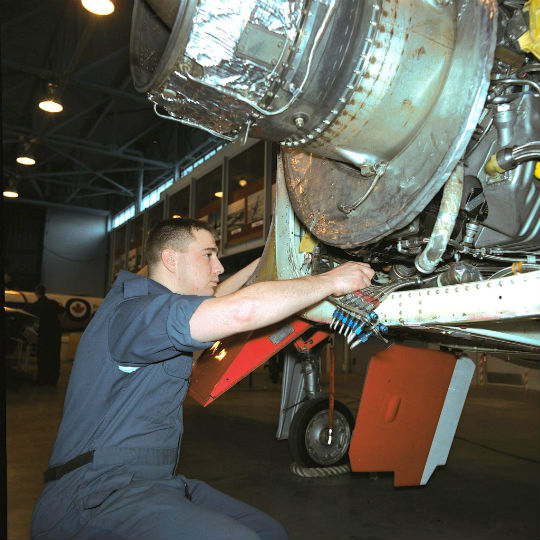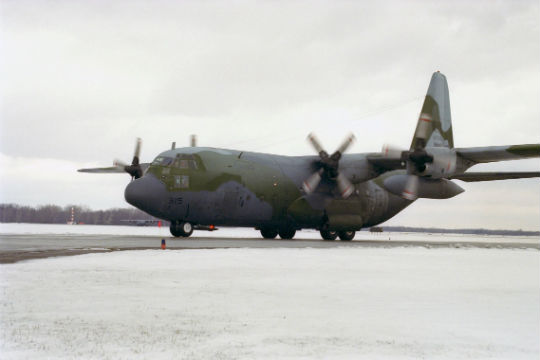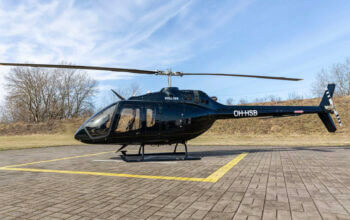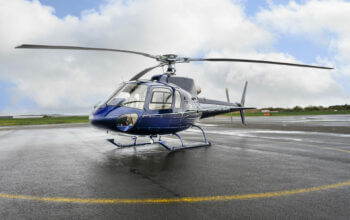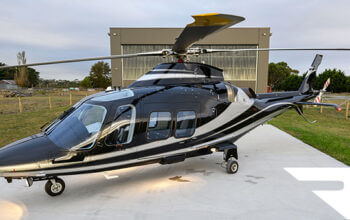With its potentially hazardous components and materials removed, and its reusable components removed and stored as spare parts, the hollow shell of Royal Canadian Air Force CC-130E Hercules No. 310 begins its reduction to recyclable metal ingots. The process is carried out by Schnitzer Steel in Surrey, B.C. Schnitzer Steel Photo
“These aircraft have provided a valuable, diplomatic-style resource to Canada for 50 years,” said Matt Black. “If you needed to take food to a ravaged part of the world, they were perfect for doing that. If you needed to take troops, they were perfect for that, too. They have served the foreign affairs needs and desires for 50 years.”
As eulogies for aircraft go, this is pretty good – short, complimentary and heartfelt.
Black, with director aerospace equipment program management (transport and helicopters), is involved with the disposal process for the E-model CC-130 Hercules aircraft.
Canada acquired the first of these workhorses in 1960. Since then, they’ve been transporting aid, equipment, Canadian Armed Forces personnel, vehicles, victims of natural disasters – basically, anything that would fit in a cargo deck that could be configured for almost anything.
All this to say, the CC-130E Hercules aircraft was a solid investment for Canada.
But that was then. Now, the Royal Canadian Air Force (RCAF), already in possession of H- and J-models, is divesting itself of the E-model Hercs. It’s been a slow process.
“The problem is, Lockheed was fairly successful at selling these back in the ’60s, and everyone has them,” Black says. “And there are H-models that are being retired now, so no one wants to buy Es. They sat on the website forever but nobody was interested. That added three or so years to the whole process. It is an eight- or nine-year process, to settle on disposal or an alternate outcome.”
That website belongs to Public Works and Government Services Canada (PWGSC) and it’s called GCSurplus. Everything for sale by the federal government goes through the site: Desks, ships, safety equipment, binders, aircraft – anything the government wants to sell. GCSurplus is also responsible for disposal service contracting.
Within the Assistant Deputy Minister Materiel [ADM(Mat)] group, the team responsible for the disposal program is the directorate of supply chain operations (DSCO). Within DSCO, the disposal sales, artifacts and loans (DSAL) section is responsible for oversight of the disposal of surplus major platforms such as aircraft fleets. DSAL works with life-cycle managers within the ADM(Mat) group to both draft the disposal plan and oversee and track it through to completion.
DSAL also works with PWGSC to sell surplus assets through GCSurplus, and with Canadian defence attachés to market surplus assets to foreign allies.
But before big-ticket items such as Canadian Armed Forces fleets land on the GCSurplus website – or on allies’ runways – they must go through a three-stage process.
Whether those fleets comprise aircraft, ships or tanks, the priorities, considerations and evaluations cover the same bases and are aimed at producing the same results: a disposal process that provides the Crown – and therefore the taxpayers of Canada – the best value while also ensuring that the guidelines and requirements of the Canadian Armed Forces, the Government of Canada, and the international community, are followed and met.
For RCAF fleets, these guidelines and requirements cover a wide range of actions:
- handling the armaments of retired aircraft safely and according to Canadian and international regulations;
- cleaning, repurposing, recycling or destroying components and materials that could be hazardous to people or to the environment;
- retrieving components that can be cleaned and stored properly to provide spare parts down the road;
- ensuring the safe operation of components and systems destined to serve as authentic training platforms for mechanics, technicians, operators, engineers and the like;
- ensuring that a museum requesting the donation of an aircraft will display it safely and appropriately; and many more.
Stage 1 – Determining when
Because the Canadian Armed Forces’ environments – the Royal Canadian Navy, the Canadian Army and the RCAF – are each responsible for managing their equipment fleets, they are best positioned to forecast the need to retire a fleet, to determine when that retirement should be scheduled, and to determine the disposition of the retired assets. The three elements produce 10-year divestment forecasts as part of the business planning process.
The lead organization in the first stage of the disposal process of RCAF aircraft is the RCAF itself. This first stage can be short and straightforward – or very long and arduous. Many factors influence the timing of the retirement and disposal of a fleet of aircraft, and also the disposal process itself, and these factors must all be identified, evaluated, and costed out long before the actual disposal and replacement will be necessary.
At 16 Wing Borden, Ont., Private Michael Zebierre, an aviation technician student at the Canadian Forces School of Aerospace Technology and Engineering, disassembles the J85 jet engine of a CT-114 Tutor aircraft. Cpl Denis Matte Photo
DSAL works with the elements to track and assist in the declaration of surplus assets, and in the case of a fleet of aircraft, once all of these factors are weighed and measured, the vice chief of the defence staff (VCDS) is the approving authority for platforms deemed surplus. When the VCDS has signed the “declaration of surplus,” a fleet is deemed ready for disposal.
“We had 19 E-model Hercules aircraft that we needed to get rid of,” Black said. “They had been declared surplus to the operational requirement by the VCDS. We came up with a plan – a bunch of plans, actually – for what we would do with the 19 of them: convert them into training aids for people on the newer Herc aircraft, or give them to museums.”
Stage 2 – Determining how
In the second stage of the disposal process, the ADM(Mat) group develops and approves disposal plans.
The first evaluation made in this step is the condition of the platform. In the case of the CC-130E Hercules, its maker, Lockheed Martin Inc., still makes components in its Marietta, Ga., U.S. factory. Hercules aircraft have never fallen victim to a dearth of replacement parts, which means most Hercs are in good shape. This evaluation enabled the RCAF and ADM(Mat) to consider the full scope of possible futures for the fleet – everything from the outright sales of airworthy aircraft to the reduction of aircraft to recyclable scrap – bearing in mind, of course, that the avenues of disposal chosen must represent the best value for the Crown.
Market interest, either in complete aircraft or in aircraft components serving as spare parts, weighs into the disposal process, tying into determining the best value for the Crown. In the case of airworthy aircraft, PWGSC/GCSurplus may negotiate sales of a fleet, or of individual aircraft, to allied air forces or legitimate private concerns that have expressed interest. This is always deemed the best outcome because it involves a one-step process and cash in hand.
And it is the sentimental favourite of everyone who has anything to do with the aircraft, because aircraft become greater than the sum of their parts in the eyes of those who fly and maintain them.
Controlled Goods/U.S. International Traffic in Arms Regulations (ITAR) and environmental and hazardous materials regulations must also be factored into the second-stage evaluation process.
“When the Hercules was sold to us, it was subject to the American government’s ITAR – the International Traffic in Arms Regulations,” said Black. “If we want to sell the aircraft, we have to get the licence from the American State Department because they have to control where this ‘arm’ – this weapon – goes.”
Unless a fleet is being sold “as is” – airworthy aircraft to be flown by an allied nation – every aircraft in a fleet must be examined and stripped down, if necessary, to enable technicians to remove weapons systems and related electronics. As well, potentially hazardous devices such as the explosive charges that activate ejection seats are removed.
Finally, materials that are or could be hazardous to those handling them or to the environment are removed. Some of these various components and materials may be stockpiled for reuse; others may be destroyed.
“And airworthiness regulations say that any parts that have not been properly maintained must be made completely unusable,” added Black. “We don’t want a time-expired piece of equipment working its way back into the supply chain and getting used on another aircraft. It becomes very important that we properly dispose of everything.”
Some components of aircraft may be considered intellectual property – add-ons that are innovative in nature, for example. The ultimate legal ownership of the original idea and/or design may remain with the designer. If this is the case, then these components or add-ons are removed from the aircraft and either returned from whence they came or destroyed, with proof of destruction recorded.
In June 2005, RCAF CC-130E Hercules No. 325 taxis at 8 Wing Trenton, Ont. After this Herc was retired in September 2010, all of its potentially dangerous components and its reusable components were removed before it was reduced to scrap for recycling. Pte Frieda Van Putten Photo
Aircraft destined to be used for spare parts may be left with their components in situ until those components are needed, or may be stripped of parts to be stockpiled and then shredded.
Aircraft destined to be held intact or to have sections or components held intact for use as static trainers for technicians and maintainers have their fuel tanks and lines drained and flushed with a light oil to ensure the moving parts are lubricated.
DSAL staff work with directorate of history and heritage staff to provide for those assets retained by the Department of National Defence for alternative applications such as training aids or internal monuments.
“No. 307 is currently flying, and it will be the last one to be retired,” Black said. “The museum here in Ottawa has asked for that one; it will be a significant milestone, the retirement of the last one of that fleet of aircraft.”
Ottawa’s Canada Aviation and Space Museum has a comprehensive collection of retired RCAF aircraft. The museum also has a world-class team of maintainers, historians, and public relations experts who will keep No. 307 airworthy and in the public’s eye.
Artifact retention or transfer is the disposal process outcome that most often directly affects Canadians. Some of the aircraft so disposed of are sold to organizations or museums that continue to fly them in airshows and at museum airfields. Some that will not fly again, but retain their taxiing capabilities, may be used as RCAF cadet trainers.
Some of these aircraft become static displays that Canadians can view and, in some cases, climb onto or even into. And some are the ever-popular “planes on a stick” you see at the gates and on the lawns of RCAF wings and RCAF Association chapters, and in other public venues throughout Canada.
Donations of aircraft are restricted to registered (with Canada Revenue Agency), not-for-profit organizations, and no-cost transfers are restricted to other government departments or to allied nations.
All of these repurposed aircraft help broaden Canadians’ knowledge and understanding of the aircraft that flew in major conflicts, helped open up Canada’s North and flew on search and rescue missions or delivered aid and assistance around the world.
Stage 3 – Doing it
In the third stage of the disposal process, the ADM(Mat) group executes disposal plans that may include sales, transfers, donations, historical preservation, or scrapping.
The outcome that no one really wants to see is scrapping. Because Lockheed Martin was so successful at selling the E-model Hercules worldwide, and because it is almost 50 years behind the current star, the J model, GCSurplus had no takers for the RCAF’s E-model Hercs. And with as many transfers, donations and historical preservations arranged as possible, probably nine of the RCAF’s E-models will be shredded and reduced for recycling.
“GCSurplus moved organizations within the government, and we had to restart the process each time,” said Black. “But they have issued a contract to Schnitzer Steel. And, right now, there are four or five of them out in British Columbia, set to be chewed apart.”
While scrapping is not a desired outcome, the contract with Schnitzer Steel certainly meets the most important requirement of the disposal process.
“We issued Schnitzer a contract,” Black said. “But they’re actually paying us for that metal. They paid us for the privilege of coming in and chopping up that metal and running it through their mill.
“From a public works point of view, it’s an unusual contract in that we’re not paying them; they’re paying us. So that metal is their resource to sell on the open market.”
For DSAL staff, the final task in the disposal process is working with DND comptrollers to ensure that the disposed-of assets are adjusted appropriately in departmental records.
Given recent fluctuations in the price of aluminum, those departmental records could show that the CC-130E Hercules aircraft are still proving themselves a solid investment for Canada.
– With files from Jeremy Clendenning, ADM(Mat) DSCO

